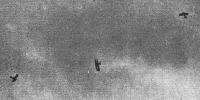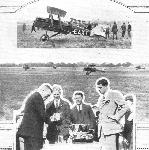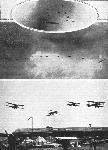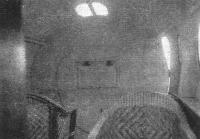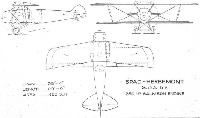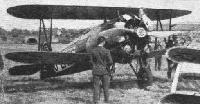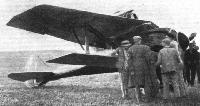Фотографии
-
AT THE R.A.F. PAGEANT: A batch of Snipes
Самолёты на фотографии: Sopwith Snipe / 7F.1 - Великобритания - 1918
-
AN EVENT AT THE PAGEANT: Event 2, two Snipes attacking a Bristol Fighter, which was eventually "brought down in flames." The Snipe on the right is on its back, and the Bristol, in the centre, is diving out of the danger zone of the second Snipe.
Самолёты на фотографии: Bristol F.2A/F.2B Fighter - Великобритания - 1916Sopwith Snipe / 7F.1 - Великобритания - 1918
-
AT THE PAGEANT. Event 13 - which was an unlucky number for the kite balloon. The Snipe on the left is leaving the formation to attack the balloon, and on the right the kite balloon is seen falling to the ground in flames.
Самолёты на фотографии: Sopwith Snipe / 7F.1 - Великобритания - 1918
-
Event 11, the Relay Race: The Kenley Snipe flying home the winner.
Самолёты на фотографии: Sopwith Snipe / 7F.1 - Великобритания - 1918
-
EVENT 9 AT THE PAGEANT: The attack on three Handley Page bombers by five Snipes. In the first picture the latter are seen swooping down and firing their guns, and below two of the Handley Pages are sent down "in flames." To the left Mr. Newel "escapes" from the third Handley Page, and to make certain, uses three parachutes!
Самолёты на фотографии: Handley Page H.P.12 (O/400) - Великобритания - 1917Sopwith Snipe / 7F.1 - Великобритания - 1918
-
AN EVENT AT THE PAGEANT: Event 5, formation flying by Snipes. The first two machines (at top) have executed a half-loop and are continuing their flight upside down - the other three are about to follow suit.
Самолёты на фотографии: Sopwith Snipe / 7F.1 - Великобритания - 1918
-
The Sopwith Snipe (F/O J.Oliver, A.F.C) winning the race.
Самолёты на фотографии: Sopwith Snipe / 7F.1 - Великобритания - 1918
-
Регистрационный номер: G-EAXT THE OXFORD AND CAMBRIDGE AIR RACE: At top, the S.E.5A machines lined up before the start. In the centre photograph the machines are seen getting away, and below the Home Secretary, Mr. Shortt, is presenting the Cups to The winning Cambridge Team, Messrs. H. A. Francis, R. K. Muir, and W. S. Philcox.
Самолёты на фотографии: RAF S.E.5 - Великобритания - 1916
-
THE AERIAL DERBY. Photographs of the starters. 7. S.E.5A. (Two of these machines were starters; but as they were identical we only publish photograph of one)
Самолёты на фотографии: RAF S.E.5 - Великобритания - 1916
-
FROM THE AERIAL PAGEANT IN EGYPT: Some of the Handley Pages which performed the function of char-a-bancs admirably although having seen service at the front.
Самолёты на фотографии: Handley Page H.P.12 (O/400) - Великобритания - 1917
-
BOMBING THE "VILLAGE" AT THE PAGEANT: Event 14. Top right, the village of Scrappa Plain, before the attack. The building on the right is the Inn noted for its Lager. The church steeple was originally an aeroplane fuselage. The Albatross biplane in the foreground "went up" on the first bombs being dropped. On left, the Bristol bombers drop their first "pills" on the deserted village, the "inhabitants" having just made good their escape. Below, right, the village well alight. The Albatross (on extreme right) has just "come down."
Самолёты на фотографии: Bristol F.2A/F.2B Fighter - Великобритания - 1916
-
AT THE R.A.F. PAGEANT: Event 7, formation flying by Bristol Fighters. After each evolution they closed up into regular formation as shown in the top photograph. In the centre picture they are seen flying abreast past the Royal Box. Note R.33 in both these photos. In the bottom picture the machines are about to land in the aerodrome.
Самолёты на фотографии: Bristol F.2A/F.2B Fighter - Великобритания - 1916
-
AT THE R.A.F. PAGEANT: A batch of Bristol fighters
Самолёты на фотографии: Bristol F.2A/F.2B Fighter - Великобритания - 1916
-
FROM THE AERIAL PAGEANT IN EGYPT: A line of Avros used for passenger "flips".
Самолёты на фотографии: Avro Avro 504 - Великобритания - 1913
-
Регистрационный номер: F8748 Avro 504 K (Siddeley "Lynx" and various Rotary Engines). "Old Avros never die, but always fly away" should become the popular "flying" song of the R.A.F. First designed in 1912, the Avro type 504 is still largely used in the Service - of course, considerably modified, but fundamentally the same. Various types of rotary engines are installed, and recently the Siddeley "Lynx" has been fitted with successful results. The squadrons equipped with Avro 504K's are :- Nos. 24 (Communications), 502 (S.R. Ulster), 503 (S.R. Waddington), 600, 601(A.A.F. Northolt), 602 (A.A.F. Renfrew), 603 (A.A.F. Turnhouse), 605 (A.A.F. Castle Bromwich).
Самолёты на фотографии: Avro Avro 504 - Великобритания - 1913
-
AT THE R.A.F. PAGEANT: A batch of Avros.
Самолёты на фотографии: Avro Avro 504 - Великобритания - 1913
-
FROM THE AERIAL PAGEANT IN EGYPT: A "Jazz" Avro which caused much merriment by going up with smoke pouring out of the funnel aft of the cockpit and with an officer hanging on to the flagstaff attached to the top centre-section.
Самолёты на фотографии: Avro Avro 504 - Великобритания - 1913
-
THE AERIAL DERBY. Photographs of the starters. 3. Sopwith Pup
Самолёты на фотографии: Sopwith Pup - Великобритания - 1916
-
Регистрационный номер: G-EAUM THE AERIAL DERBY. Photographs of the starters. 1. Avro Baby two-seater
Самолёты на фотографии: Avro Baby / Type 534 - Великобритания - 1919
-
Регистрационный номер: G-EAXM ONE OF THE "MIGHT-HAVE-BEEN'S": The Avro Racer, 450 h.p. Napier "Lion" engine.
Самолёты на фотографии: Avro 539 - Великобритания - 1919
-
THE AERIAL DERBY. Photographs of the starters. The Avro-Viper, 200 h.p. Wolseley "Viper."
Самолёты на фотографии: Avro Type 552 - Великобритания - 1921
-
AN EVENT AT THE PAGEANT: Duel between a Siddeley-Nighthawk and a Siddeley-Siskin - the latter is seen at the top making a sharp turn after the latter. Below is "R.33" hovering in the haze.
Самолёты на фотографии: Armstrong Whitworth (Siddeley) S.R.2 Siskin - Великобритания - 1919Nieuport & General Nighthawk - Великобритания - 1918
-
Регистрационный номер: F-ACMA [4] THE SPAD "BERLINE": Side view.
Самолёты на фотографии: Bleriot-SPAD S.33 / S.46 / S.50 / S.56 / S.66 - Франция - 1920
-
Регистрационный номер: F-ACMA [4] THE SPAD "BERLINE": Three-quarter front view.
Самолёты на фотографии: Bleriot-SPAD S.33 / S.46 / S.50 / S.56 / S.66 - Франция - 1920
-
Регистрационный номер: F-ACMA [4] THE SPAD "BERLINE": Front view.
Самолёты на фотографии: Bleriot-SPAD S.33 / S.46 / S.50 / S.56 / S.66 - Франция - 1920
-
Регистрационный номер: F-ACMA [4] THE SPAD "BERLINE": Three-quarter rear view. Note the two petrol tanks on the top plane.
Самолёты на фотографии: Bleriot-SPAD S.33 / S.46 / S.50 / S.56 / S.66 - Франция - 1920
-
THE SPAD "BERLINE": View inside the cabin, looking forward. Note emergency exit in roof.
Самолёты на фотографии: Bleriot-SPAD S.33 / S.46 / S.50 / S.56 / S.66 - Франция - 1920
-
SPAD-Herbemont S.33 bis 250 hp Salmson Engine
Самолёты на фотографии: Bleriot-SPAD S.33 / S.46 / S.50 / S.56 / S.66 - Франция - 1920
-
THE AERIAL DERBY : A.S.Butler on the Bristol Tourer makes a sharp turn rounding the pylon starting for bis second circuit.
Самолёты на фотографии: Bristol Tourer - Великобритания - 1919
-
Регистрационный номер: G-EAWB THE AERIAL DERBY. Photographs of the starters. 4. Bristol Tourer
Самолёты на фотографии: Bristol Tourer - Великобритания - 1919
-
Регистрационный номер: G-EAWY BRISTOL TEN-SEATER. The Bristol Type 62 Ten-Seater first flew on 18th January 1924. A successor to the Type 26 Pullman triplane of 1920, the 450-h.p. Napier Lion, Srs. II-powered Type 62 in turn gave way to the Types 75 and 75A, Ten-Seater and Express Freighter - both being powered by 425-h.p. Bristol Jupiter IV radials. In the Type 62, the pilot and mechanic sat side-by-side in an open cockpit forward of the upper mainplane. With a span of 54 ft., and length of 42 ft., the Type 62 Ten-Seater possessed a maximum speed of 122 m.p.h. for an a.u.w. of 8,800 lb. It was later used on European services undertaken by Handley Page Transport Ltd.
Самолёты на фотографии: Bristol Ten-Seater / Brandon - Великобритания - 1921
-
Bristol Commercial Ten-seater 450 H.P. Napier "Lion" Engine
Самолёты на фотографии: Bristol Ten-Seater / Brandon - Великобритания - 1921
-
Регистрационный номер: G-EAXZ THE WINNER OF THE AERIAL DERBY: Two views of the Mars I.
Самолёты на фотографии: Gloster Mars (Bamel) / Nighthawk / Sparrowhawk - Великобритания - 1921
-
SOME DETAILS OF THE MARS I: On the left the cowling over the engine. Note the "spinner," which is built integral with the propeller, and the petrol tank above the fuselage.
Самолёты на фотографии: Gloster Mars (Bamel) / Nighthawk / Sparrowhawk - Великобритания - 1921
-
THE MARS I: Details of the shock absorbers and their streamline casings.
Самолёты на фотографии: Gloster Mars (Bamel) / Nighthawk / Sparrowhawk - Великобритания - 1921
-
Mars I 450 hp Napier Lion Engine
Самолёты на фотографии: Gloster Mars (Bamel) / Nighthawk / Sparrowhawk - Великобритания - 1921
-
Регистрационный номер: G-EATS THE AERIAL DERBY. Photographs of the starters. 9. Bristol Bullet
Самолёты на фотографии: Bristol Bullet - Великобритания - 1919
-
Регистрационный номер: J2415 The start of Event 1 at the Pageant, a handicap race in which eight different types of aeroplanes took part. The Handley Page (limit 'bus) has just left. The Nighthawk (scratch) in foreground.
Самолёты на фотографии: Nieuport & General Nighthawk - Великобритания - 1918
-
Another "Non-Starter": The de Monge Monoplane, which in this view is a biplane. The lower wing is readily detachable, when the machine can be flown as a parasol monoplane.
Самолёты на фотографии: De Monge Lumiere / Type 5.1 - Франция - 1921
-
Side and front views of the Remington-Burnelli "Airliner" Twin-Engine Commercial Biplane, showing the wide "aerofoil" fuselage
Самолёты на фотографии: Burnelli RB-1 / RB-2 - США - 1921
-
Самолёты на фотографии: Burnelli RB-1 / RB-2 - США - 1921
-
Another view of the Remington-Burnelli "Airliner."
Самолёты на фотографии: Burnelli RB-1 / RB-2 - США - 1921
-
An interior view of the port side of the passengers' cabin, the full accommodation of which is 30.
Самолёты на фотографии: Burnelli RB-1 / RB-2 - США - 1921
-
THE REMINGTON-BURNELLI "AIRLINER" TWIN-ENGINE COMMERCIAL BIPLANE. General arrangement drawings.
Самолёты на фотографии: Burnelli RB-1 / RB-2 - США - 1921
-
THE SPERRY "COMMERCIAL" WING: Two views of a Curtiss J.N. fitted with the Sperry monoplane wing (cantilever) in place of the usual biplane wings.
Самолёты на фотографии: Sperry Sport / Hi-Lift - США - 1921
Статьи
- Flight

